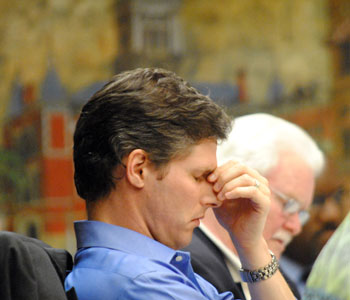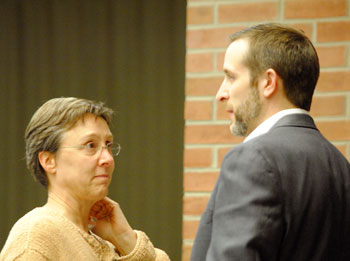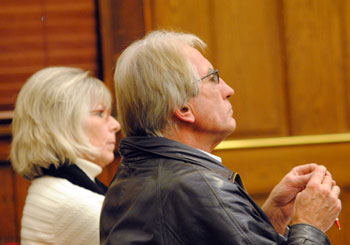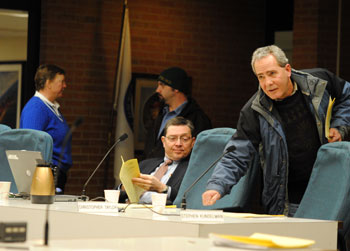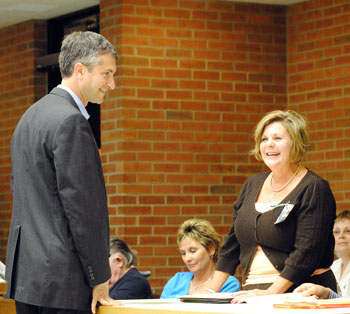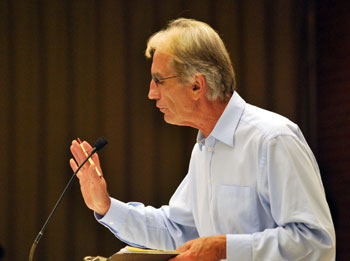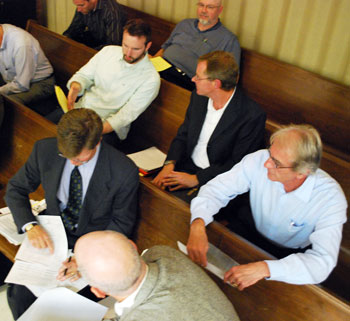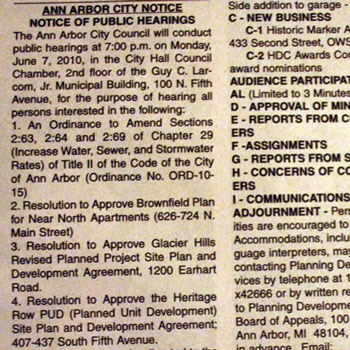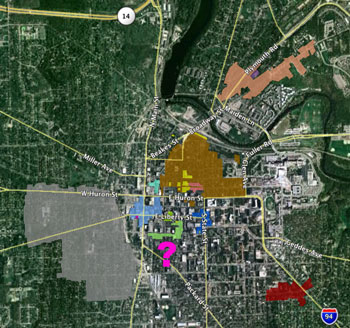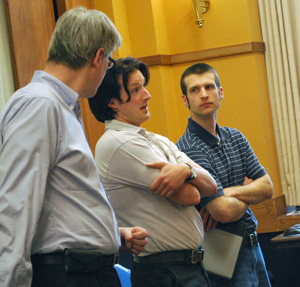Ann Arbor City Council Sunday night caucus (Sept. 19, 2010): Most residents who attended the council’s informal Sunday night meeting seemed to be keen to focus the night’s discussion on one of two topics: a possible ban on porch couches; or the future of the Library Lot on Fifth Avenue in downtown Ann Arbor. An underground parking garage is currently being constructed there, but no decision has been made about what, if anything, to build on top.
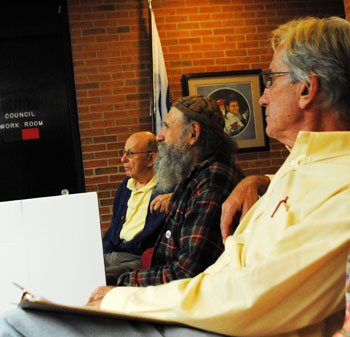
Front to back: Alex de Parry, Alan Haber, Haskell Rothstein. (Photos by the writer.)
A specific suggestion for one of various amenities that could be constructed on the lot came from Haskell Rothstein: giant chess boards, with giant pieces. Already during pre-caucus chatter, Rothstein had opened the topic of giant chess boards on the Library Lot, and that conversational gambit prompted an interesting revelation from Alex de Parry: It turns out that de Parry’s father was a chess player of some distinction, once playing Bobby Fischer to a draw.
De Parry, of course, is developer of a proposed 154-bedroom residential project called Heritage Row, which would have been located on Fifth Avenue, a few squares south of the Library Lot. Heritage Row was rejected by the council at its June 21, 2010 meeting, on a 7-4 vote in favor of it, falling one vote short of the super-majority needed to approve the planned unit development (PUD) project. The super-majority was needed because of a protest petition filed by nearby property owners.
Heritage Row was brought back for reconsideration at a subsequent council meeting on July 6, 2010, but again failed, that time on a 7-3 vote. It was nearly brought back a third time – on that same evening. But Carsten Hohnke (Ward 5) abandoned the effort in the middle of a parliamentary procedure that had appeared momentarily would result in another vote, this time with Hohnke providing the deciding vote in favor of Heritage Row. Hohnke had voted against the project on both previous occasions.
De Parry has an already approved “matter of right” 144-bedroom project in the same location as Heritage Row – called City Place. Approved last year, the City Place project contrasts with Heritage Row in that it would demolish seven existing houses and replace them with a streetscape consisting of two buildings separated by a parking lot. In the Heritage Row project, the seven houses would be renovated, and three additional buildings would be constructed behind them, with parking located under the site.
De Parry would like to begin construction in May 2011 – on either Heritage Row or City Place – and he indicated at the caucus meeting that the necessary lead time for permitting means that work on construction drawings needs to start now. So de Parry’s negotiations with city councilmembers to bring back Heritage Row for reconsideration have entered the end game.
During the caucus conversation, de Parry discussed with Mike Anglin (Ward 5) and Sabra Briere (Ward 1) – the only two councilmembers present at the caucus – the meetings and correspondence they’d had with each other and other councilmembers on the possibility that changes to Heritage Row might win a third consideration from the council. Previously, Anglin and Briere had both voted against the project, as did Carsten Hohnke (Ward 5) and Stephen Kunselman (Ward 3). So one of those four would need to see significant enough modifications in Heritage Row to change their vote.
On Sunday evening, however, Briere told de Parry: “As near as I can tell, nobody is budging.” De Parry then indicated to Briere and Anglin: “We’re going to start on the other project [City Place].” Briere’s reply: “I mourn that.”
Additional topics discussed at the caucus included porch couches, panhandling, the future of the Library Lot, religious tolerance, and the format of the caucus meeting itself.
[Full Story]




